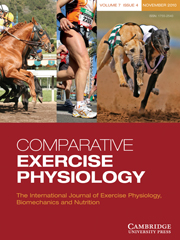Article contents
The influence of horse gender on eventing competition performance
Published online by Cambridge University Press: 01 May 2008
Abstract
The study undertook comparative analysis of horse gender and eventing performance. Limited previous research has investigated the impact horse gender may have on performance. However, many competitors have a preference for one gender over another (normally geldings). The study sampled five levels of the sport (intro, pre-novice, novice, intermediate and advanced) and investigated dependent variable penalty scores within the dressage, show jumping and cross-country phases; additionally, final penalty score, rank in competition and lifetime score were analysed. Results indicated the effect of gender to be limited. Issues relating to sample size, data structure and scoring mechanisms are discussed further.
Keywords
Information
- Type
- Research Paper
- Information
- Copyright
- Copyright © Cambridge University Press 2008
References
- 3
- Cited by

